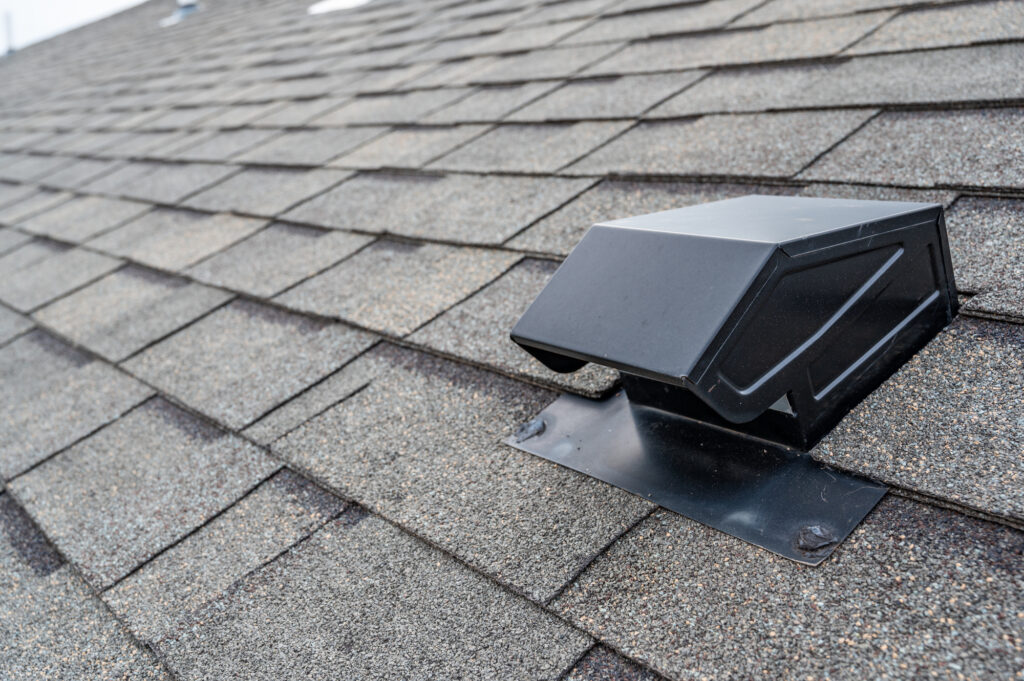For each type of roof and each unique property, finding the right approach to roof ventilation is essential for the longevity of your roofing installation and many other facets of a building’s structural and environmental health. Consequently, it is important to consult with a roofing expert, like Ranch Roofing, when planning to repair or protect an existing roof by adding roof vents or considering a new roof and associated ventilation needs. After all, investing in your roof contributes both to overall property value and to the safety and service of the roof and building for years to come. Below, we’ve outlined common types of roof vents and the factors that influence their selection.
Types of Roof Vents
Roof vent work requires cutting into the roof, so ventilation features are best incorporated during a new roof installation. If you’ve had any air quality or flow concerns in the past, discussing these issues during the process of your roof upgrade helps the professional roofers collaborate with you about which types of roof vents may be best for your building, its inhabitants and its daily operations.
There are two main types of attic or roof ventilation: active and passive. The active systems use electricity to facilitate air flow, while passive mechanisms rely on existing air movement from wind to transport air in and out of the vents. The goal of either type of roof vent system is to exchange the warmer and more humid air that may have accumulated in the home for cooler and dryer air. While heat and humidity may seem like the norm during some seasons or in specific locations, thoughtful ventilation strategies must be implemented to aid in the roof’s longevity, as well as a building’s energy efficiency, air circulation and temperature management.
Here are some common types of roof vents:
- Gable Vents: These passive vents are located in triangular areas created by peaked roofing on outer attic-level walls, usually on the ends of a building. Many property owners also enjoy how they complement the look of a building, as well as their service in releasing accumulated hot, humid air.
- Ridge Vents: While gable vents are located below the roof itself, ridge vents are often found along the full length of the roof’s ridge. Since they are relatively indistinguishable from the roof itself, this type of passive roof vent is one of the least noticeable air and moisture exhaust features.
- Soffit Vent: Designed to support the availability of fresh air into the attic and throughout the home, this type of roof vent is located underneath the roof’s overhang or eaves. Their variety in size and shape makes this type of roof vent a versatile choice.
- Attic Fans: Attic fans are active and power-based systems that pull new air in and remove old air. While not installed on any part of the roof itself, this type of ventilation helps support roof health from below.
- Turbine Vent: This wind-powered system is relatively low maintenance and is another type of passive ventilation. Many property owners enjoy this choice because it is friendly to the environment and to energy bills!
- Solar Vent: Another eco-friendly option that draws on the sun to power its operations, this exhaust system contributes to energy efficiency through its design and efficient heat and humidity removal.
How to Choose the Right Types of Roof Vents
Effective ventilation requires finding the right balance of ventilation for each building. Often, this optimal air management is done by combining different types of roof vents, since each one has its own air flow and ventilation capability. In addition to any existing building code compliance needs or ventilation systems, consider the following factors to help determine the right types of roof vents for your residential or commercial building.
- Assess roofing material options. Roofing materials have different thermal properties, so the type of roofing material will directly impact temperature and ventilation regulation.
- Evaluate the size and design of the roof. Bigger or more complex roofing systems often require a greater number of roof vents to regulate air circulation and moisture buildup.
- Consider the climate. One combination of ventilation options may help to prevent ice dams in colder regions, while another may be better suited to areas with continuous moisture and high temperatures.
- Address attic space usage. For example, the air circulation, temperature management and moisture control needs of an attic used as a bonus storage area will likely differ from one used as a guest bedroom with an ensuite bathroom.
Ultimately, roof vent integration and selection can significantly impact a building’s overall energy efficiency, air circulation and quality, temperature and humidity management, and roof lifespan. The professional roofing and ventilation experts at Ranch Roofing can help you determine which types of roof vents will work best for your home or commercial location. With our nuanced understanding of the climate of our service area and how this factor impacts the roofing and ventilation needs of each unique building, our team is ready to discuss which types of roof vents may be beneficial for you, as well as any other roofing services that you may need. Contact us today for a free estimate on your upcoming project!
